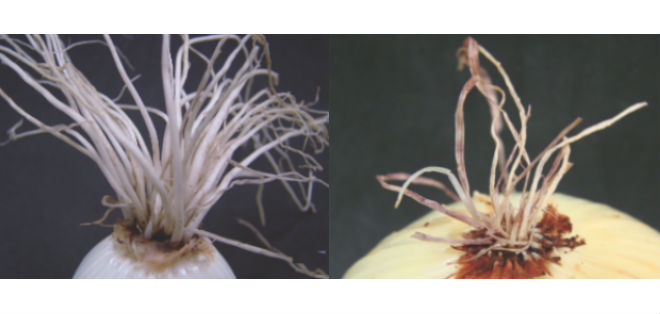
Mar 20, 2017Study suggests new approaches to onion disease
Bacterial leaf blight, caused by Pantoea agglomerans, has been a limiting factor for Michigan onion growers in recent years. The bacterium was isolated from onion plants in Ottawa County in 2011 and was the first documented case of this pathogen occurring in Michigan.
According to Mary Hausbeck, professor and Extension specialist at Michigan State University (MSU), more expansive studies have been conducted since 2014 confirming that P. agglomerans affected onion fields in Allegan, Calhoun, Eaton, Ingham, Newaygo and Ottawa counties.
Speaking at the most recent Great Lakes Fruit, Vegetable & Farm Market EXPO in Grand Rapids, Michigan, Hausbeck said a collaborative study with Zsofia Szendrei of MSU’s Department of Entomology was conducted and indicated that an increase in thrips is associated with an increase in bacterial leaf blight. This study also showed that limiting thrips with an effective insecticide program could also limit bacterial leaf blight.
Along with bacterial leaf blight, onion growers are also managing additional serious leaf blights caused by fungal pathogens including stemphylium, Hausbeck said.
An aggressive pathogen in Michigan for the last couple of growing seasons, stemphylium is not always readily controlled by the fungicide programs that limit purple blotch. Newly registered fungicides may offer some assistance to limit stemphylium leaf blight.


Evaluating fungicides
Hausbeck said a study was conducted at a grower’s farm in Hamilton, Michigan. Gunnison seeds were sown on raised beds consisting of eight rows of plants spaced 6 inches apart and 2 inches within a row. A completely randomized block design with four replicates was established in an area 100 feet long by seven beds.
Treatments were applied as a foliar spray and reapplied at seven-day intervals using a CO2 backpack sprayer and a broadcast boom equipped with three XR8003 flat-fan nozzles with the outer nozzles angled toward the center, calibrated at 50 psi and delivering 50 gallons per acre.
Disease severity was assessed using the Horsfall-Barratt scale. Onions from the center 5 feet of the four rows of the treatment plots were harvested, dried, topped, graded and weighed. Data were analyzed using an analysis of variance, with means separation performed using Fisher’s protected least significant difference, according to Hausbeck.
Hausbeck said necrosis of the leaves was the result of bacterial leaf blight, anthracnose, and stemphylium leaf blight. All treatments were significantly better than the untreated control at the final rating.
Both rates of Luna Tranquility SC significantly limited disease symptoms in comparison to all other treatments. The lower rate of Luna Tranquility SC (12 fluid ounces per acre) was just as effective at controlling disease symptoms as the higher rate (1 pint per acre); therefore, growers can consider using the lower rate without jeopardizing disease control in their onion fields.
Fontelis SC was similar to the higher rate of Luna Tranquility SC (1 pint) in its efficacy. Fontelis SC is recommended to be used with an adjuvant, such as 1 percent methylated seed oil (MSO), on onions, which could have improved its results. The recommended application rate for Fontelis SC is 16 to 24 fluid ounces per acre. Luna Tranquility SC and Fontelis SC are both included in the fungicide group. “It is important that growers alternate between these and other fungicides with different modes of action to limit the development of resistance,” Hausbeck said.

Pink root, onion root age
Pink root, incited by Setophoma terrestris, reduces bulb size and yield, Hausbeck said.
“Early infection by the pink root pathogen has been associated with premature bulb formation that greatly limits yield and quality,” she said. “Infected roots appear light pink in color, become dark red or purple, shrivel, die and finally detach from the plant.
The above-ground symptoms of severely infected plants may resemble drought stress. Infected plants commonly survive but are stunted and produce small bulbs due to restriction of the root system, according to Hausbeck.
“Over the years, our observations included a significant amount of pink root disease in many of Michigan’s onion fields,” Hausbeck said. “To address this, an ambitious research program was initiated to examine potential avenues of management, as our observations indicated that pink root is damaging productivity.”
Historically, producers considered pink root an insignificant problem, as it was associated primarily with onions already senescing at season’s end. However, producers who have moved to mineral soils that do not have a history of onion production (and pink root) are experiencing a significant benefit, she said.
The objective of this pink root study was to determine if plant age influences the ability of S. terrestris to colonize onion root cells. Onion cultivars that represent a high level of susceptibility (Highlander) and a low level of susceptibility (Hendrix) to pink root were chosen.
Hendrix and Highlander onions were inoculated with the pathogen at 3, 5, 7 or 9 weeks old, and evaluated for disease. Root density, plant height, fresh weight, number of total leaves per plant and bulb circumference were compared between healthy and diseased plants of the same age.
“The results show that the density of the root system was reduced as a result of pink root infection, regardless of onion age or cultivar,” Hausbeck said.
When three-week-old Highlander plants were inoculated with S. terrestris, plant height, fresh weight and bulb circumference were significantly reduced compared to healthy plants.
“When 3- or 5-week old Hendrix onion plants were inoculated with the pink root pathogen, the bulb circumference was reduced compared to healthy plants,” she said.
Microscopic observation revealed both young and older roots were infected with the pink root pathogen. As the roots age, there is more colonization by S. terrestris. However, the greatest reduction in onion plant and bulb size occurred when roots were infected by the pink root pathogen when they were young.
“Hendrix onions that have been shown to be less susceptible to pink root in previous field studies showed a reduced frequency of root colonization in this study than the more susceptible cultivar Highlander,” Hausbeck said.
— Gary Pullano, associate editor
















